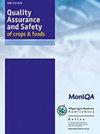Research of the determination method of furfurals and furosine in milk and the application in the quality evaluation of milk
IF 5.3
3区 农林科学
Q1 FOOD SCIENCE & TECHNOLOGY
引用次数: 5
Abstract
The heat treatment process usually affects the quality and safety of milk and could produce different compounds, including furosine and furfurals. To help evaluate the effect of different heating temperatures on furfurals, a method based on gas chromatography-mass spectrometry (GC-MS) combined with QuEChERS (quick, easy, cheap, effective, rugged, and safe) extraction technology was used to detect four furfural compounds, including furfural, 2-acetylfuran, 5-methyl-2-furfural, and 5-hydroxymethyl-2-furfural. A sample extraction was performed with acetonitrile, and the use of both octadecylsilyl (C18) and primary secondary amine (PSA) sorbents can pro-vide satisfactory recoveries. The determination of furosine was performed by using a high performance of liquid chromatography method (HPLC), and the milk samples were hydrolyzed with HCl for 18 h at 110°C. Under the optimized conditions, good linearity was obtained with linear correlation coefficients (R2) above 0.99, and the recovery values from the spiked samples were 88.1–109.5%. The limits of detection were in the range of 0.005 mg/kg–0.015 mg/kg. The established GC-MS and HPLC methods were successfully applied to market milk samples and heat-treatment samples. The highest detection values for 5-hydroxymethyl-2-furfural and furosine were 0.051 mg/kg and 593.2 mg/100 g protein, respectively, in charcoal-flavored fermented milk. It showed a high cor-relation between the formation of 5-hydroxymethyl-2-furfural with the treatment temperature and time, and the maximum content was 0.886 mg/kg after heating for 180 min at 100°C. However, there was no noticeable linear increase of furosine concentrations when certain temperatures and heating times were reached; the maximum value was 55.0 mg/L after heating for 60 min at 100°C, and 55.4 mg/L after heating for 150 min at 80°C.牛奶中糠醛和糠氨酸的测定方法及其在牛奶质量评价中的应用研究
热处理过程通常会影响牛奶的质量和安全,并可能产生不同的化合物,包括糠氨酸和糠醛。为评价不同加热温度对糠醛的影响,采用气相色谱-质谱联用QuEChERS(快速、简便、廉价、有效、可靠、安全)提取技术对糠醛、2-乙酰呋喃、5-甲基-2-糠醛、5-羟甲基-2-糠醛等4种糠醛化合物进行了检测。用乙腈对样品进行萃取,十八烷基硅基(C18)和伯仲胺(PSA)吸附剂均可获得满意的回收率。采用高效液相色谱法(HPLC)测定糠氨酸的含量,牛奶样品在110℃下用盐酸水解18 h。在优化条件下,加样回收率为88.1 ~ 109.5%,线性关系良好,线性相关系数(R2) > 0.99。检出限范围为0.005 mg/kg ~ 0.015 mg/kg。建立的气相色谱-质谱和高效液相色谱方法成功地应用于市售牛奶样品和热处理样品。5-羟甲基-2-糠醛和糠氨酸在炭味发酵乳中的最高检出值分别为0.051 mg/kg和593.2 mg/100 g蛋白质。结果表明,5-羟甲基-2-糠醛的生成与处理温度和时间有较高的相关性,在100℃下加热180 min后,5-羟甲基-2-糠醛的含量最高为0.886 mg/kg。然而,当达到一定温度和加热时间时,糠氨酸浓度没有明显的线性增加;在100℃下加热60 min,其最大值为55.0 mg/L;在80℃下加热150 min,其最大值为55.4 mg/L。
本文章由计算机程序翻译,如有差异,请以英文原文为准。
求助全文
约1分钟内获得全文
求助全文
来源期刊

Quality Assurance and Safety of Crops & Foods
FOOD SCIENCE & TECHNOLOGY-
CiteScore
4.60
自引率
7.50%
发文量
61
审稿时长
1 months
期刊介绍:
''Quality Assurance and Safety of Crops & Foods'' is an international peer-reviewed journal publishing research and review papers associated with the quality and safety of food and food sources including cereals, grains, oilseeds, fruits, root crops and animal sources. It targets both primary materials and their conversion to human foods. There is a strong focus on the development and application of new analytical tools and their potential for quality assessment, assurance, control and safety. The scope includes issues of risk assessment, traceability, authenticity, food security and socio-economic impacts. Manuscripts presenting novel data and information that are likely to significantly contribute to scientific knowledge in areas of food quality and safety will be considered.
''Quality Assurance and Safety of Crops & Foods'' provides a forum for all those working in the specialist field of food quality and safety to report on the progress and outcomes of their research.
 求助内容:
求助内容: 应助结果提醒方式:
应助结果提醒方式:


